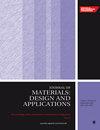三维印刷杏仁壳颗粒增强聚乳酸生物复合材料的机械和摩擦学特性
IF 2.5
4区 材料科学
Q3 MATERIALS SCIENCE, MULTIDISCIPLINARY
Proceedings of the Institution of Mechanical Engineers, Part L: Journal of Materials: Design and Applications
Pub Date : 2024-04-24
DOI:10.1177/14644207241248505
引用次数: 0
摘要
最近,用于三维打印的复合长丝开发应运而生,并被广泛应用。本研究开发了用于三维打印的纯聚乳酸和杏仁壳颗粒增强聚乳酸生物复合材料,并研究了打印方向(包括 0°、45° 和 90°)对三维打印材料的摩擦学和机械性能的影响。新型杏仁壳颗粒增强聚乳酸长丝采用长丝挤出法挤出,聚乳酸基体中含有10%的杏仁壳颗粒,样品采用熔融长丝制造技术进行三维打印。针对不同的三维印刷方向,对拉伸、弯曲、压缩强度和邵氏硬度等机械特性进行了评估。根据长度和直径偏差分析了三维印刷聚乳酸复合材料样品的表面质量。90° 取向的聚乳酸和杏仁壳颗粒增强聚乳酸生物复合材料样品的长度精度分别达到 99.12% 和 98.81%。研究表明,在聚乳酸基体中添加杏仁壳颗粒会降低抗弯和抗拉强度。在各种印刷方向中,0° 平面样品可使纯聚乳酸和杏仁壳颗粒增强聚乳酸复合材料的最大抗拉强度分别达到 36 和 28 兆帕。杏仁壳颗粒增强聚乳酸生物复合材料的接触角最小,为 54°。在以 0° 印刷方向进行三维印刷的纯聚乳酸上观察到的最高接触角值为 94°。在干燥条件下,通过改变滑动速度(1、2 和 3 m/s)和载荷(10、20 和 30 N),在针盘摩擦磨损试验机上进行了摩擦学研究。结果表明,在 10 N 的滑动载荷下,0° 印刷方向的杏仁壳颗粒增强聚乳酸生物复合材料样品的摩擦系数最小,为 0.22。本文章由计算机程序翻译,如有差异,请以英文原文为准。
Mechanical and tribological behaviour of three-dimensional printed almond shell particles reinforced polylactic acid bio-composites
Recently, composite filament development for three-dimensional printing has emerged and is used for numerous applications. The present research work develops neat polylactic acid and Almond Shell Particles reinforced polylactic acid bio-composites for three-dimensional printing and investigates the effects of printing orientation, including 0°, 45° and 90° orientation, on the tribological and mechanical behaviours of three-dimensional printed materials. The novel almond shell particles reinforced polylactic acid filaments are extruded by the filament extrusion method with the presence of 10% almond shell particles in the polylactic acid matrix, and the samples are three-dimensional printed by the fused filament fabrication technique. Mechanical characteristics such as tensile, flexural, compressive strength, and shore hardness are evaluated with respect to various three-dimensional printing orientations. The surface quality of the three-dimensional printed polylactic acid composite samples is analysed with respect to length and diameter deviation. Length accuracy of the 90° oriented polylactic acid and almond shell particles reinforced polylactic acid bio-composite samples exploits a better accuracy of 99.12% and 98.81%, respectively. It is shown that adding almond shell particles to the polylactic acid matrix decreases the flexural and tensile strength. Among the printing orientations, 0° flat samples result in the maximum tensile strength of 36 and 28 MPa for the neat polylactic acid and almond shell particles reinforced polylactic acid composites, respectively. The lowest contact angle of 54° is observed on the almond shell particles reinforced polylactic acid bio-composites three-dimensional printed with a 90° orientation. The highest contact angle value of 94° is observed on the neat polylactic acid three-dimensional printed with a 0° printing orientation. A tribological study is carried out under dry conditions on the pin-on-disc tribometer by varying the sliding speed (1, 2, and 3 m/s) and load (10, 20, and 30 N). The result shows that the lowest coefficient of friction of 0.22 is achieved for the almond shell particles reinforced polylactic acid bio-composite samples with a 0° printing orientation under a sliding load of 10 N. These kinds of newly developed compostable materials can be used for developing disposable orthotic foot appliances.
求助全文
通过发布文献求助,成功后即可免费获取论文全文。
去求助
来源期刊

CiteScore
4.70
自引率
8.30%
发文量
166
审稿时长
3 months
期刊介绍:
The Journal of Materials: Design and Applications covers the usage and design of materials for application in an engineering context. The materials covered include metals, ceramics, and composites, as well as engineering polymers.
"The Journal of Materials Design and Applications is dedicated to publishing papers of the highest quality, in a timely fashion, covering a variety of important areas in materials technology. The Journal''s publishers have a wealth of publishing expertise and ensure that authors are given exemplary service. Every attention is given to publishing the papers as quickly as possible. The Journal has an excellent international reputation, with a corresponding international Editorial Board from a large number of different materials areas and disciplines advising the Editor." Professor Bill Banks - University of Strathclyde, UK
This journal is a member of the Committee on Publication Ethics (COPE).
 求助内容:
求助内容: 应助结果提醒方式:
应助结果提醒方式:


